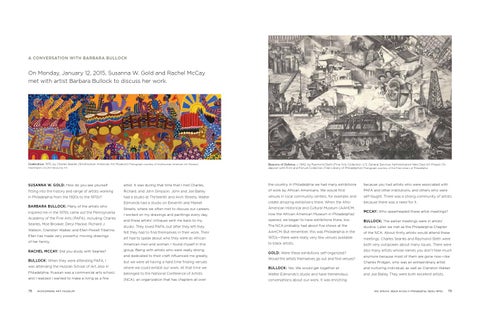A CONVERSATION WITH BARBARA BULLOCK
On Monday, January 12, 2015, Susanna W. Gold and Rachel McCay met with artist Barbara Bullock to discuss her work.
Celebration, 1975, by Charles Searles (Smithsonian American Art Museum) Photograph courtesy of Smithsonian American Art Museum, Washington, DC/Art Resource, NY
Beacons of Defense, c. 1942, by Raymond Steth (Fine Arts Collection, U.S. General Services Administration New Deal Art Project On deposit with Print and Picture Collection, Free Library of Philadelphia) Photograph courtesy of the Free Library of Philadelphia
SUSANNA W. GOLD: How do you see yourself
artist. It was during that time that I met Charles,
the country. In Philadelphia we had many exhibitions
because you had artists who were associated with
fitting into the history and range of artists working
Richard, and John Simpson. John and Joe Bailey
of work by African Americans. We would find
PAFA and other institutions, and others who were
had a studio at Thirteenth and Arch Streets; Walter
venues in local community centers, for example, and
self-taught. There was a strong community of artists
Edmonds had a studio on Eleventh and Market
create amazing exhibitions there. When the Afro-
because there was a need for it.
Streets, where we often met to discuss our careers.
American Historical and Cultural Museum (AAHCM,
I worked on my drawings and paintings every day,
now the African American Museum in Philadelphia)
and these artists’ critiques sent me back to my
opened, we began to have exhibitions there, too.
BULLOCK: The earlier meetings were in artists’
studio. They loved PAFA, but after they left they
The NCA probably had about five shows at the
studios. Later we met as the Philadelphia Chapter
felt they had to find themselves in their work. Their
AAHCM. But remember, this was Philadelphia in the
of the NCA. About thirty artists would attend these
art had to speak about who they were as African
1970s—there were really very few venues available
meetings. Charles Searles and Raymond Steth were
American men and women. I found myself in this
to black artists.
both very outspoken about many issues. There were
in Philadelphia from the 1920s to the 1970s? BARBARA BULLOCK: Many of the artists who
inspired me in the 1970s came out the Pennsylvania Academy of the Fine Arts (PAFA), including Charles Searles, Moe Brooker, Deryl Mackie, Richard J. Watson, Cranston Walker, and Ellen Powell Tiberino. Ellen has made very powerful, moving drawings of her family. RACHEL MCCAY: Did you study with Searles?
group. Being with artists who were really strong and dedicated to their craft influenced me greatly,
GOLD: Were these exhibitions self-organized?
Would the artists themselves go out and find venues?
MCCAY: Who spearheaded these artist meetings?
also many artists whose names you don’t hear much anymore because most of them are gone now—like
BULLOCK: When they were attending PAFA, I
but we were all having a hard time finding venues
was attending the Hussian School of Art, also in
where we could exhibit our work. At that time we
BULLOCK: Yes. We would get together at
and nurturing individual, as well as Cranston Walker
Philadelphia. Hussian was a commercial arts school,
belonged to the National Conference of Artists
Walter Edmonds’s studio and have tremendous
and Joe Bailey. They were both excellent artists.
and I realized I wanted to make a living as a fine
(NCA), an organization that has chapters all over
conversations about our work. It was enriching
78
WOODMERE ART MUSEUM
Charles Pridgen, who was an extraordinary artist
WE SPEAK: Black Artists in Philadelphia, 1920s–1970s
79
